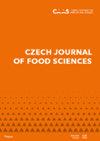植物添加剂:欧芹叶和红甜椒对无蛋小麦面食品质的影响
IF 1
4区 农林科学
Q4 FOOD SCIENCE & TECHNOLOGY
引用次数: 3
摘要
意大利面在不同人群中非常受欢迎,是一种健康廉价的产品。因此,意大利面因其富含功能性成分而成为一个很有前途的对象。研究了红甜椒粉(BPP)和香菜叶粉(PLP)用于提高面食生物价值的可能性和可行性。研制了添加红BPP和PLP的意大利面条生产配方。研究了红甜椒粉和香菜叶粉对面食理化性质和烹饪性能的影响。意大利面的富集导致最佳烹饪时间、膨胀指数(SI)和吸水指数(WAI)降低。与对照样品相比,植物粉的添加显著降低了意大利面的亮度(P<0.05)。另一方面,蔬菜粉的添加对面食的总多酚含量和抗氧化活性有积极影响。在富含多酚的意大利面中,多酚含量增加了一倍(含10.0%BPP的意大利面),甚至增加了两倍(含10.0%PLP的意大利面的)。感官评估的得分表明,用PLP和红色BPP强化的意大利面可以成为提供营养丰富的意大利面的技术替代品。本文章由计算机程序翻译,如有差异,请以英文原文为准。
Impact of plant additives: Parsley (Petroselinum crispum) leaves and red bell pepper (Capsicum annuum) on the quality of eggless wheat pasta
Pasta is very popular among different groups of the population, being a healthy and cheap product. Therefore, pasta is a promising object for its enrichment with functional ingredients. The paper examined the possibility and feasibility of using red bell pepper powder (BPP) and parsley leaf powder (PLP) in order to enhance the pasta biological value. Recipes of spaghetti pasta production with the addition of red BPP and PLP were developed. The effect of powders from red bell pepper and parsley leaf incorporation on the physicochemical and culinary properties of pasta was studied. The enrichment of pasta induced a decrease in optimal cooking time, swelling index (SI) and water absorption index (WAI). The addition of plant powders decreased the lightness of pasta significantly (P < 0.05) compared to the control sample. On the other hand, the addition of vegetable powders has a positive influence on the total polyphenol content (TPC) and antioxidant activity of pasta. In enriched pasta, the polyphenol content has doubled (pasta with 10.0% BPP) or even tripled (pasta with 10.0% PLP). The received scores from the sensory evaluation showed that pasta fortified with PLP and red BPP can be a technological alternative to provide nutritionally enriched pasta.
求助全文
通过发布文献求助,成功后即可免费获取论文全文。
去求助
来源期刊

Czech Journal of Food Sciences
Food Science & Technology, Chemistry-食品科技
CiteScore
2.60
自引率
0.00%
发文量
48
审稿时长
7 months
期刊介绍:
Original research, critical review articles, and short communications dealing with food technology and processing (including food biochemistry, mikrobiology, analyse, engineering, nutrition and economy). Papers are published in English.
 求助内容:
求助内容: 应助结果提醒方式:
应助结果提醒方式:


